A Suspended Six-Port Transformer-Based Power Divider for 2.4 GHz Applications
Abstract
:1. Introduction
2. The Structure of the Six-Port Power Divider
3. Fabrication of the Six-Port Transformer-Based Power Divider
4. Results and Discussion
5. Conclusions
Acknowledgments
Author Contributions
Conflicts of Interest
References
- Chung, Y.H.; Liao, C.H.; Lin, C.W.; Shih, Y.S.; Li, C.F.; Hung, M.H.; Liu, M.C.; Wu, P.A.; Hsu, J.L.; Hsu, M.Y.; et al. A dual-band 802.11abgn/ac transceiver with integrated PA and T/R switch in a digital noise controlled SoC. In Proceedings of the 2015 IEEE Custom Integrated Circuits Conference (CICC), San Jose, CA, USA, 28–30 September 2015; pp. 1–8. [Google Scholar]
- Ramella, M.; Fabiano, I.; Manstretta, D.; Castello, R. A 2.4 GHz low-power SAW-less receiver for SoC coexistence. In Proceedings of the 2015 IEEE Asian Solid-State Circuits Conference (A-SSCC), Xiamen, China, 9–11 November 2015; pp. 1–4. [Google Scholar]
- Wickert, M.; Mayer, U.; Ellinger, F. 802.11a compliant spatial diversity receiver IC in 0.25-μm BiCMOS. IEEE Trans. Microw. Theory Tech. 2012, 60, 1097–1104. [Google Scholar] [CrossRef]
- Gomez-Calero, C.; Cuellar, L.; de Haro, L.; Martinez, R. A 2 × 2 novel MIMO testbed for DVB-T2 systems. In Proceedings of the 2009 IEEE International Symposium on Broadband Multimedia Systems and Broadcasting, Bilbao, Spain, 13–15 May 2009; pp. 1–5. [Google Scholar]
- Chien, G.; Leong, P.B.; Son, S.W.; Tsai, M.; Tse, L. A fully-integrated dual-band MIMO transceiver IC. In Proceedings of the IEEE Radio Frequency Integrated Circuits (RFIC) Symposium, San Francisco, CA, USA, 11–13 June 2006. [Google Scholar]
- Zhang, L.; Zhu, X.; Chen, P.; Tian, L.; Zhai, J. Broadband four-way power divider for active antenna array application. In Proceedings of the 2013 International Symposium on Antennas & Propagation, Orlando, FL, USA, 7–13 July 2013; Volume 2, pp. 1079–1081. [Google Scholar]
- Gan, H.; Wong, S.S. Integrated transformer baluns for RF low noise and power amplifiers. In Proceedings of the IEEE Radio Frequency Integrated Circuits (RFIC) Symposium, San Francisco, CA, USA, 11–13 June 2006. [Google Scholar]
- EL-Gharniti, O.; Kerherve, E.; Begueret, J.B. A 5 GHz Low Noise Amplifier with On-Chip Transformer-Balun. In Proceedings of the 2006 European Conference on Wireless Technology, Manchester, UK, 10–12 September 2006; pp. 353–356. [Google Scholar]
- Yeh, J.F.; Yang, C.Y.; Kuo, H.C.; Chuang, H.R. A 24-GHz transformer-based single-in differential-out CMOS low-noise amplifier. In Proceedings of the 2009 IEEE Radio Frequency Integrated Circuits Symposium, Boston, MA, USA, 7–9 June 2009; pp. 299–302. [Google Scholar]
- Long, J.R. A low-voltage 5.1-5.8-GHz image-reject downconverter RF IC. IEEE J. Solid-State Circuits 2000, 35, 1320–1328. [Google Scholar] [CrossRef]
- Vorst, D.V.; Mirabbasi, S. Low-power 1V 5.8 GHz bulk-driven mixer with on-chip balun in 0.18 mmCMOS. In Proceedings of the 2008 IEEE Radio Frequency Integrated Circuits Symposium, Atlanta, GA, USA, 15–17 June 2008; pp. 197–200. [Google Scholar]
- Syu, J.S.; Lu, H.L.; Meng, C. A 0.6-V 30 GHz CMOS quadrature VCO using microwave 1:1:1 trifilar transformer. IEEE Microw. Wirel. Compon. Lett. 2012, 22, 88–90. [Google Scholar] [CrossRef]
- Lee, S.; Lee, S.; Park, H.; Kim, W.; Kwon, H.; Jeong, J.; Kwon, Y. W-band dual-channel receiver with active power divider and temperature-compensated circuit. Electron. Lett. 2016, 52, 850–851. [Google Scholar] [CrossRef]
- Weng, S.H.; Chang, H.Y. A Broadband inductorless active power divider for 10 Gbps high speed transmissions. IEEE Microw. Wirel. Compon. Lett. 2014, 24, 197–199. [Google Scholar] [CrossRef]
- Lan, X.; Lu, X.; Blumenthal, T.; Fratello, V.; Chan, W.; Truong, M.; Kiyono, K.; Zhang, Y.; Gu, G.; Tan, M. Ultra-wideband microwave components fabricated using low-cost aerosol-jet printing technology. In Proceedings of the 2015 IEEE Radio and Wireless Symposium (RWS), San Diego, CA, USA, 25–28 January 2015; pp. 156–158. [Google Scholar]
- Zhang, W.; Liu, Y.; Wu, Y.; Shen, J.; Li, S.; Yu, C.; Gao, J. Anovel planar structure for implementing power divider or balun with variable power division. Prog. Electromagn. Res. C 2014, 48, 111–123. [Google Scholar] [CrossRef]
- Trantanella, C.J. A novel power divider with enhanced physical and electrical port isolation. In Proceedings of the 2010 IEEE MTT-S International Microwave Symposium, Anaheim, CA, USA, 23–28 May 2010; pp. 129–132. [Google Scholar]
- Li, C.; Lok, L.B.; Khalid, A.; Papageorgiou, V.; Grant, J.; Cumming, D.R.S. A coplanar ring power divider with high isolation for V-band and W-band applications. In Proceedings of the 2012 42nd European Microwave Conference, Amsterdam, The Netherlands, 29 October–1 November 2012; pp. 57–60. [Google Scholar]
- Huang, C.; Chen, D.; Leidich, S.; Gessner, T. Compact meta-material transmission line balun based on meander lines structure and {MEMS} technology. Microelectron. Eng. 2010, 87, 584–587. [Google Scholar] [CrossRef]
- Hua, D.; Liao, X. X-band coplanarWilkinson power divider based on GaAsMMIC technology. Electron. Lett. 2011, 47, 758–759. [Google Scholar] [CrossRef]
- Abaei, E.; Aviles, H.M.; Shamsafar, A.; Boccia, L.; Amendola, G. Optimum design of a miniaturized onchip wide band power divider-combiner combined with impedance transformer. In Proceedings of the 2015 9th European Conference on Antennas and Propagation (EuCAP), Lisbon, Portugal, 12–17 April 2015; pp. 1–4. [Google Scholar]
- Lee, H.L.; Kim, D.Z.; Tae, H.S.; Lee, M.Q.; Yu, J.W. A balanced antenna design for six-port receiver architecture. In Proceedings of the 40th European Microwave Conference, Paris, France, 28–30 September 2010; pp. 1158–1161. [Google Scholar]
- Penirschke, A.; Mahn, T.; Angelovski, A.; Jakoby, R. Energy beam position monitor design utilizing grounded coplanar waveguide transmission line pickups and a modified six-port discriminator for particle accelerators. In Proceedings of the 2015 IEEE International Instrumentation and Measurement Technology Conference (I2MTC), Pisa, Italy, 11–14 May 2015; pp. 899–904. [Google Scholar]
- Ercoli, M.; Dragomirescu, D.; Plana, R. Small size high isolation Wilkinson power splitter for 60 GHz wireless sensor network applications. In Proceedings of the 2011 IEEE 11th Topical Meeting on Silicon Monolithic Integrated Circuits in RF Systems, Scottsdale, AZ, USA, 17–19 January 2011; pp. 85–88. [Google Scholar]
- Wheeler, H.A. Formulas for the Skin Effect. Proc. IRE 1942, 30, 412–424. [Google Scholar] [CrossRef]
- Cooke, C.M. Proximity effect of a conducting plane in electro-optic field probe measurements. In Proceedings of the Conference on Electrical Insulation & Dielectric Phenomena—Annual Report 1983, Buck Hill Falls, PA, USA, 16–20 October 1983; pp. 104–109. [Google Scholar]
- Babcock, J.A.; Balster, S.G.; Pinto, A.; Dirnecker, C.; Steinmann, P.; Jumpertz, R.; El-Kareh, B. Analog characteristics of metal-insulator-metal capacitors using PECVD nitride dielectrics. IEEE Electron Device Lett. 2001, 22, 230–232. [Google Scholar] [CrossRef]
- Ng, C.H.; Chew, K.W.; Chu, S.F. Characterization and comparison of PECVD silicon nitride and silicon oxynitride dielectric for MIM capacitors. IEEE Electron Device Lett. 2003, 24, 506–508. [Google Scholar] [CrossRef]
- Kim, S.J.; Cho, B.J.; Li, M.F.; Ding, S.J.; Zhu, C.; Yu, M.B.; Narayanan, B.; Chin, A.; Kwong, D.L. Improvement of voltage linearity in high-/spl kappa/MIM capacitors using HfO2-SiO2 stacked dielectric. IEEE Electron Device Lett. 2004, 25, 538–540. [Google Scholar] [CrossRef]
- Robertson, J. High dielectric constant oxides. Eur. Phys. J. Appl. Phys. 2004, 28, 265–291. [Google Scholar] [CrossRef]
- Ghannam, A.; Viallon, C.; Bourrier, D.; Parra, T. Dielectric microwave characterization of the SU-8 thick resin used in an above IC process. In Proceedings of the 2009 European Microwave Conference (EuMC), Rome, Italy, 29 September–1 October 2009; pp. 1041–1044. [Google Scholar]
- Pierce, R.G.; Islam, R.; Henderson, R.M.; Blanchard, A. SU-8 2000 millimeter wave material characterization. IEEE Microw. Wirel. Compon. Lett. 2014, 24, 427–429. [Google Scholar] [CrossRef]
- Kalyan, R.; Rawat, K.; Koul, S.K. Design of reconfigurable concurrent dual-band quarter-wave transformer with application of power combiner/divider. In Proceedings of the 2015 IEEE MTT-S International Microwave and RF Conference (IMaRC), Mumbai, India, 10–12 December 2015; pp. 169–172. [Google Scholar]
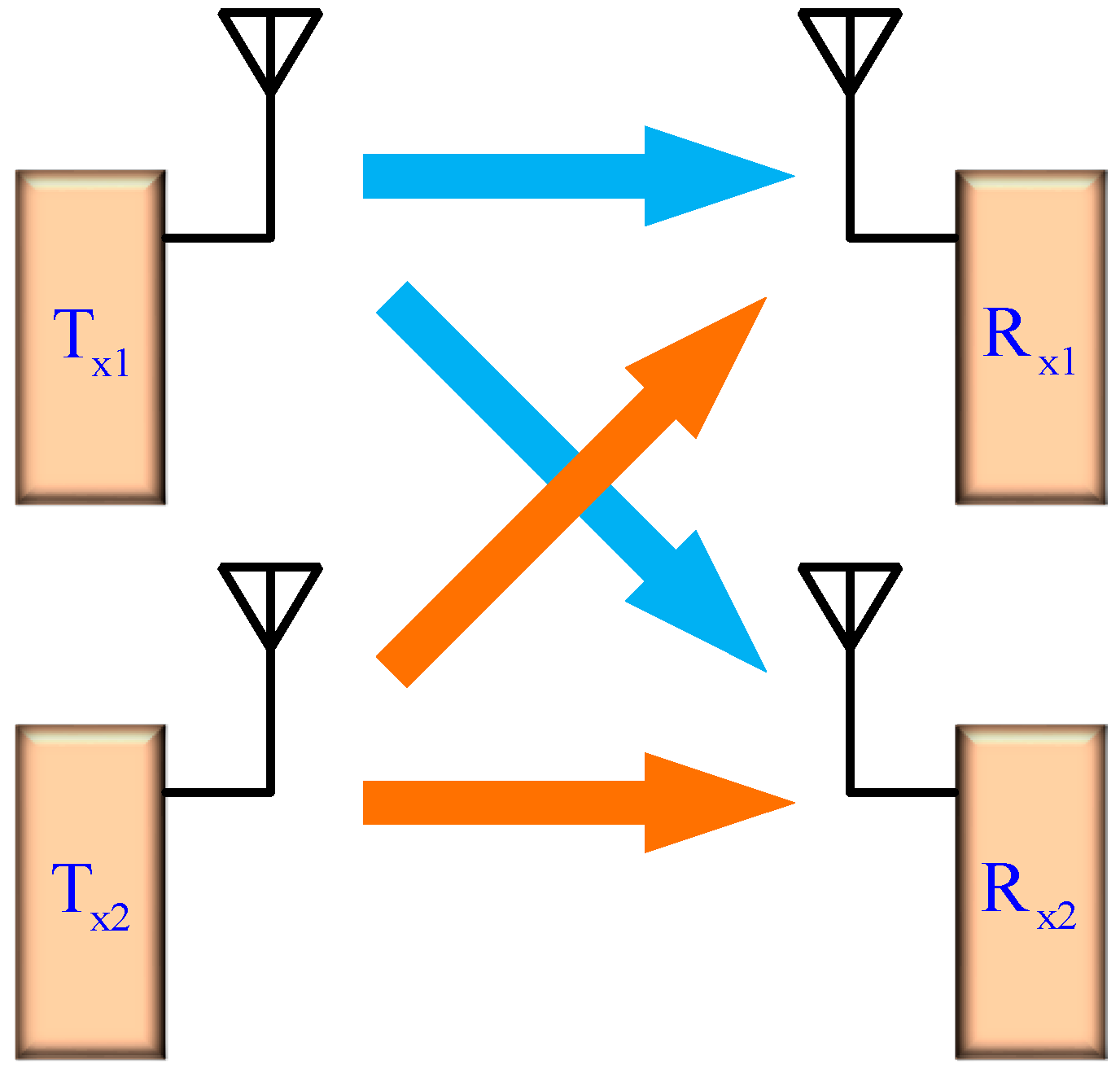
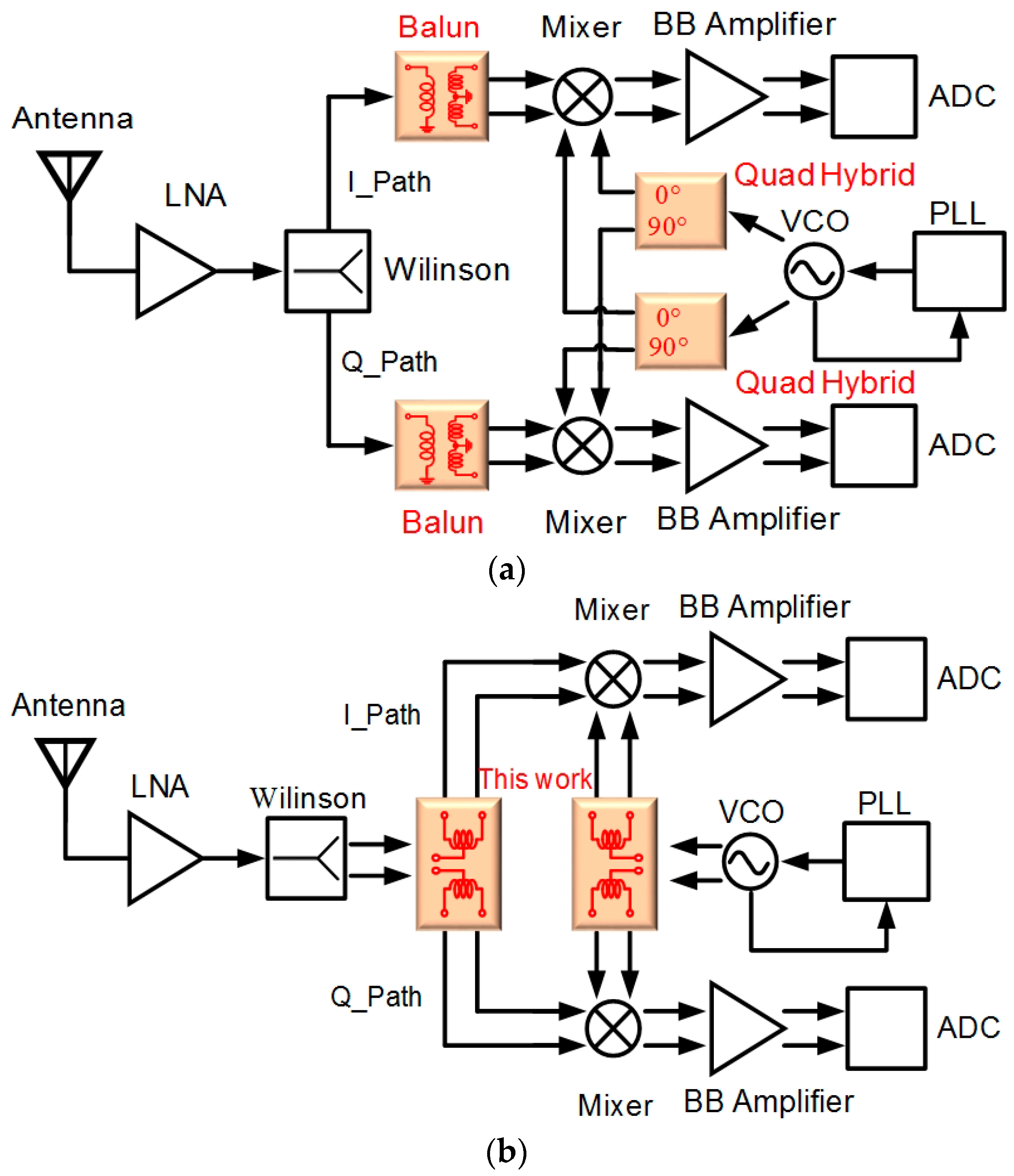


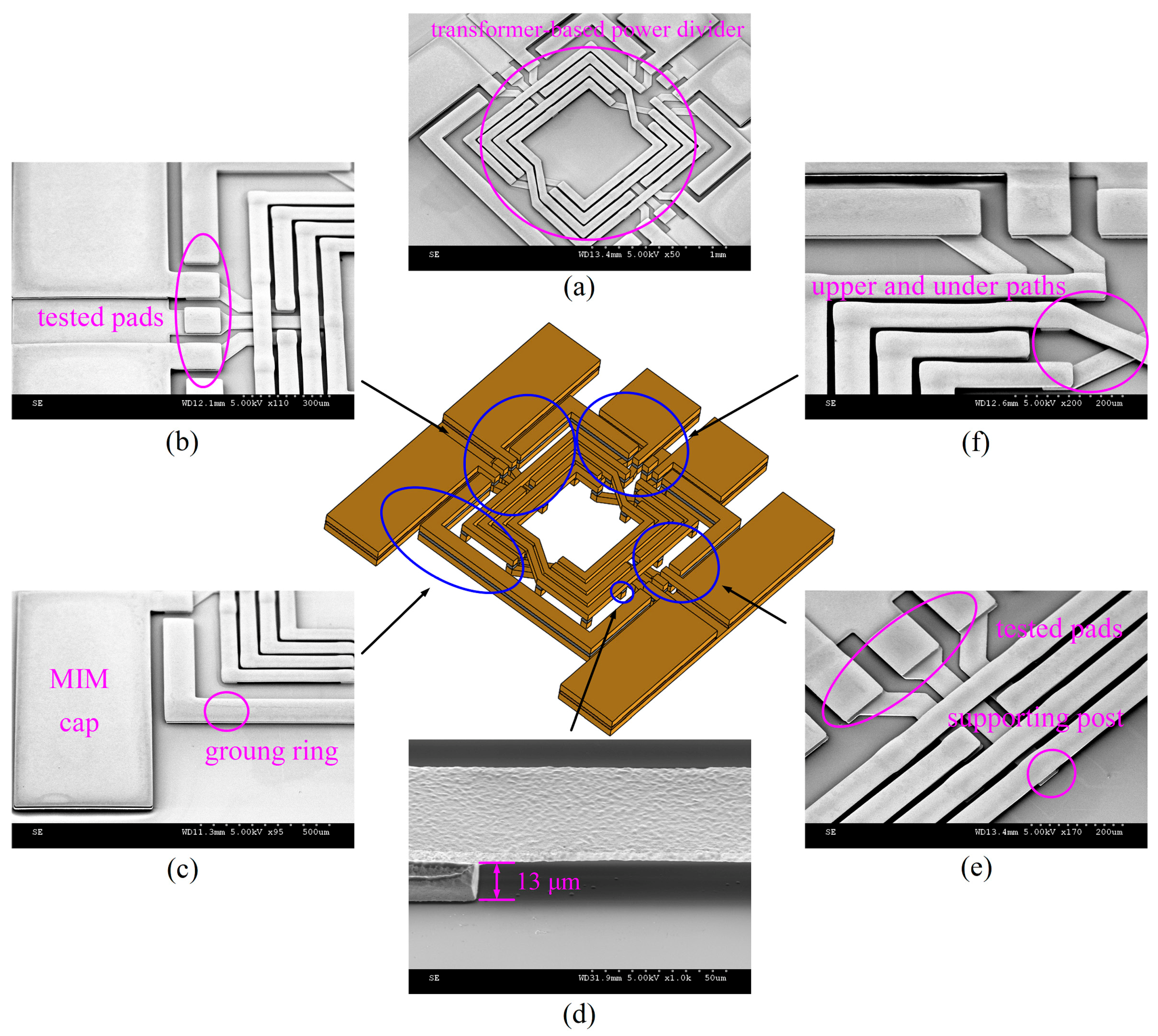
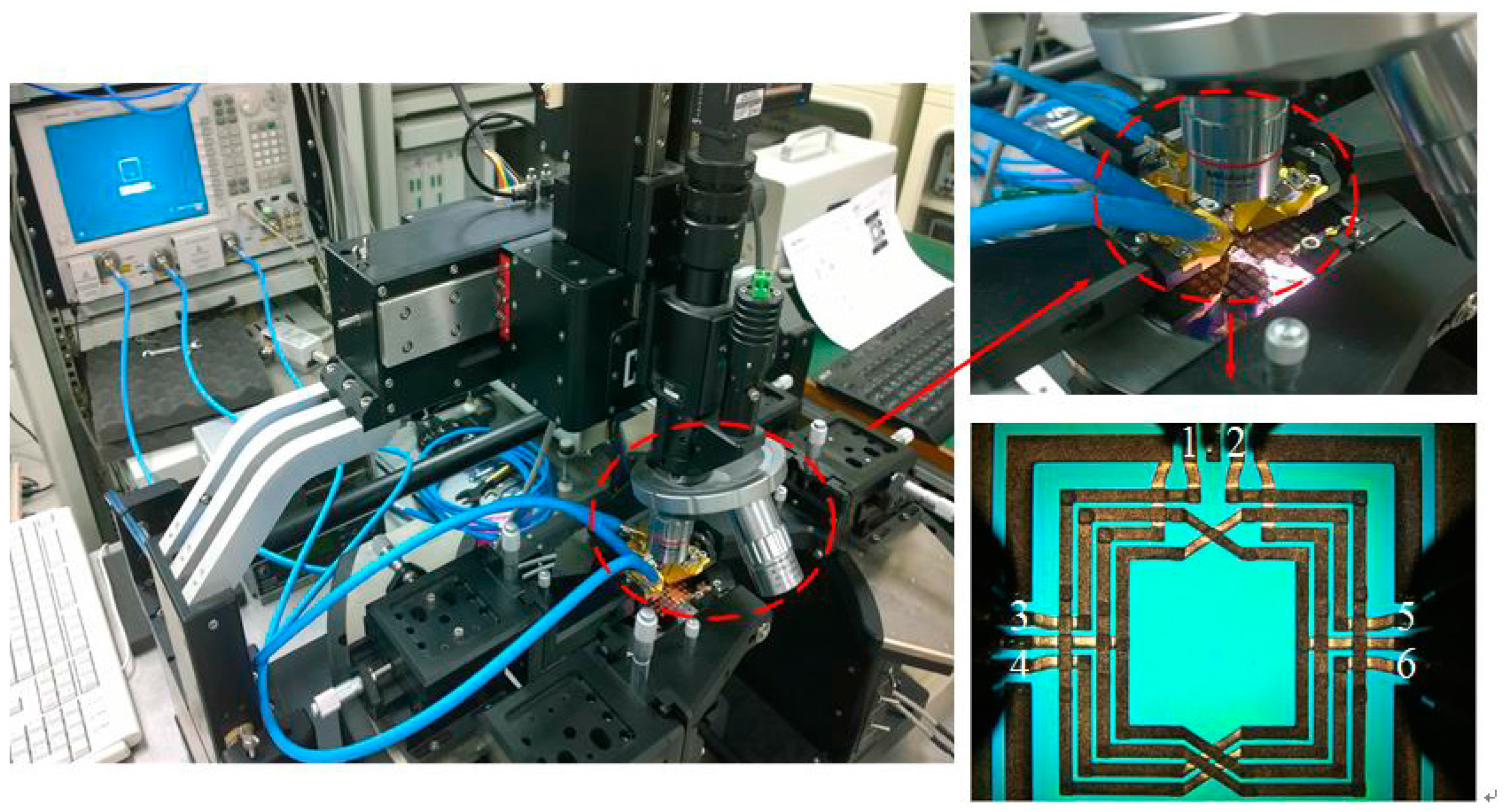
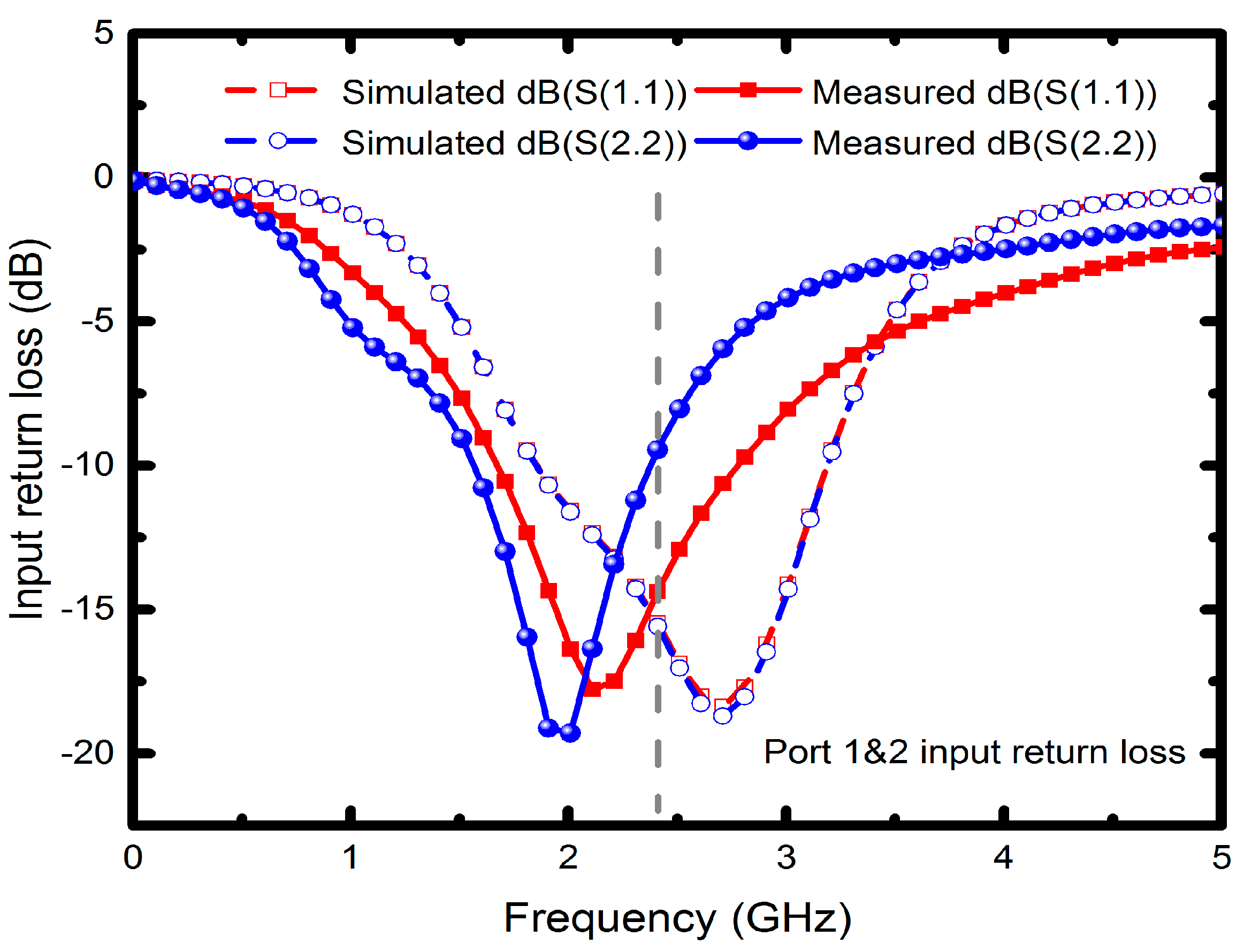
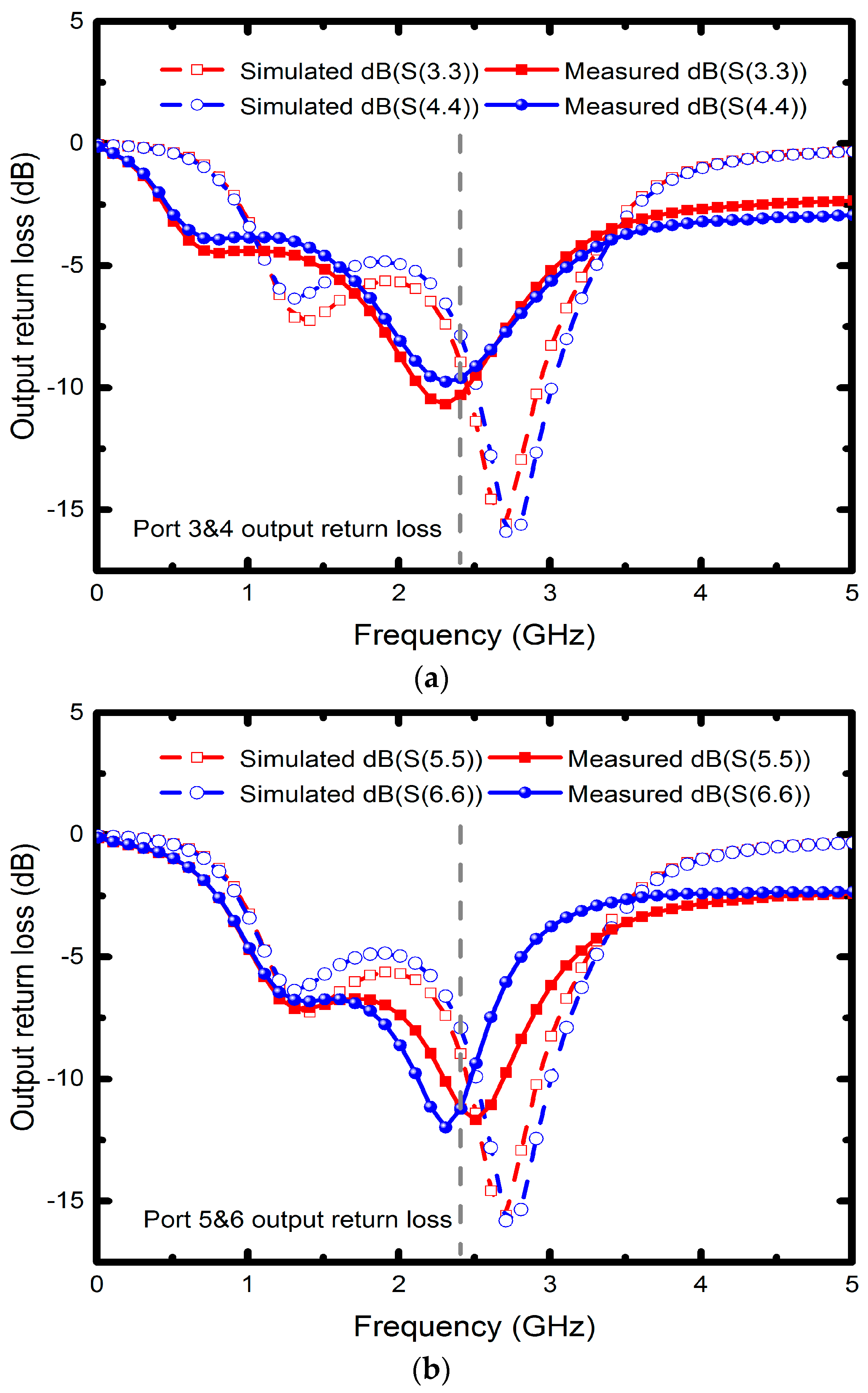
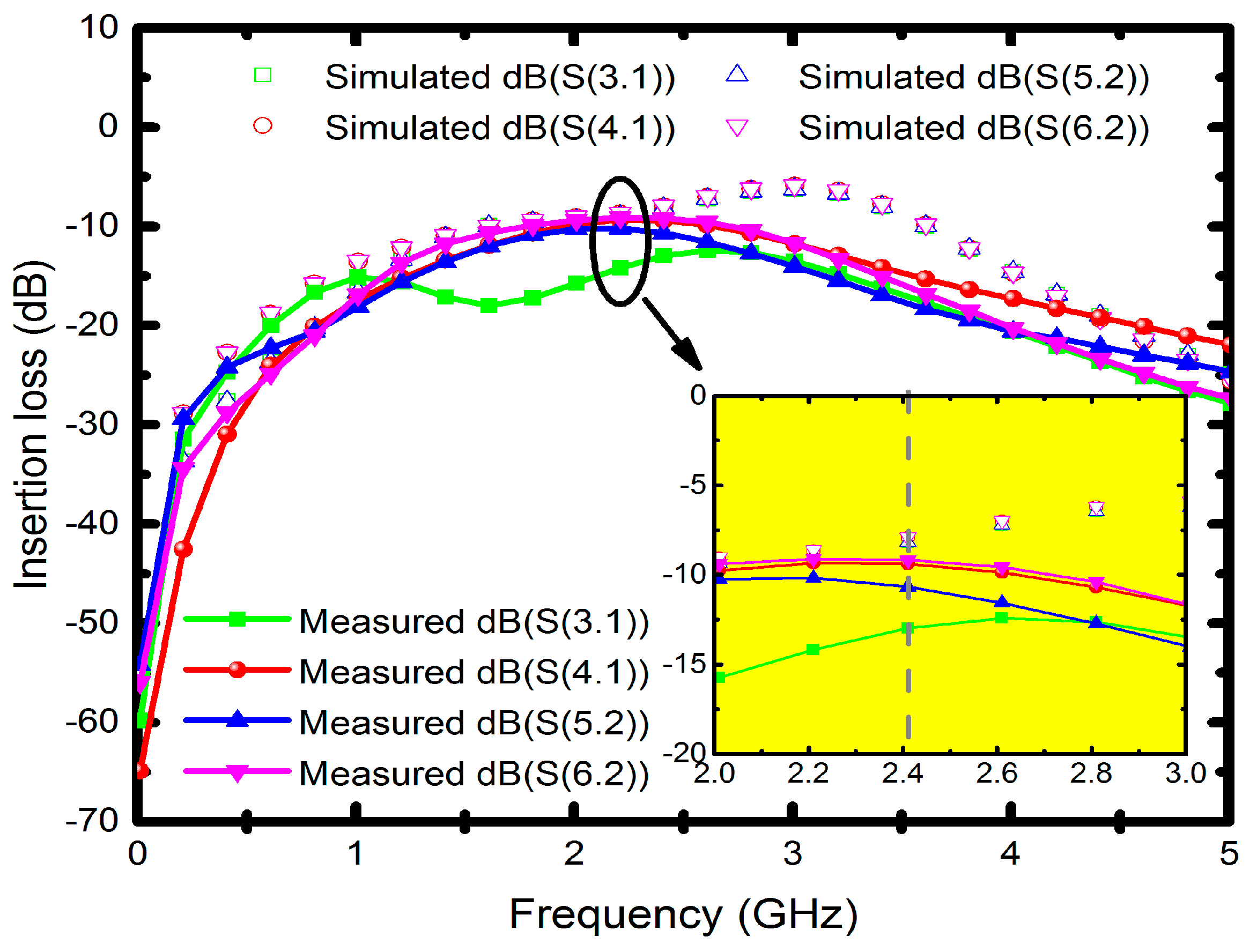
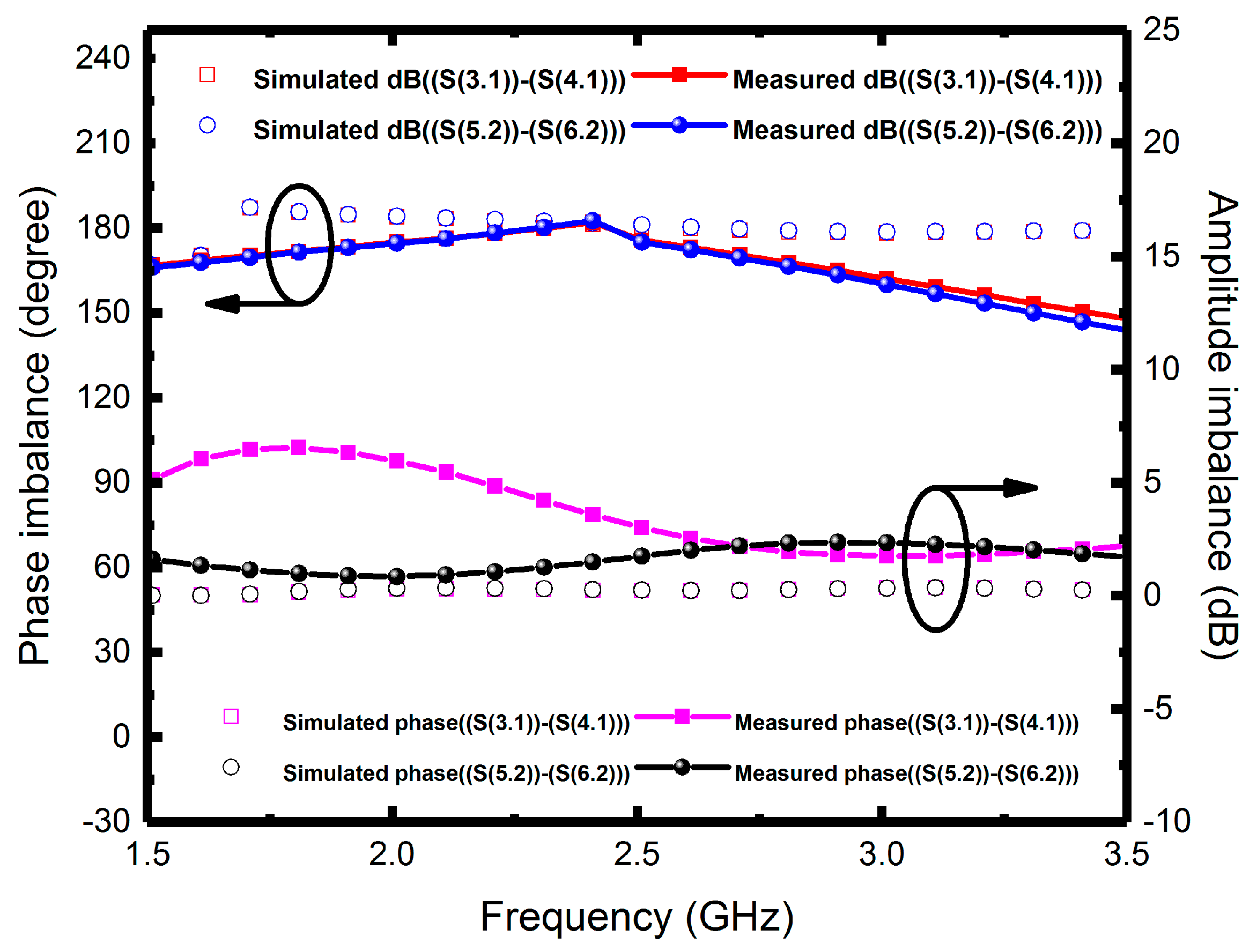
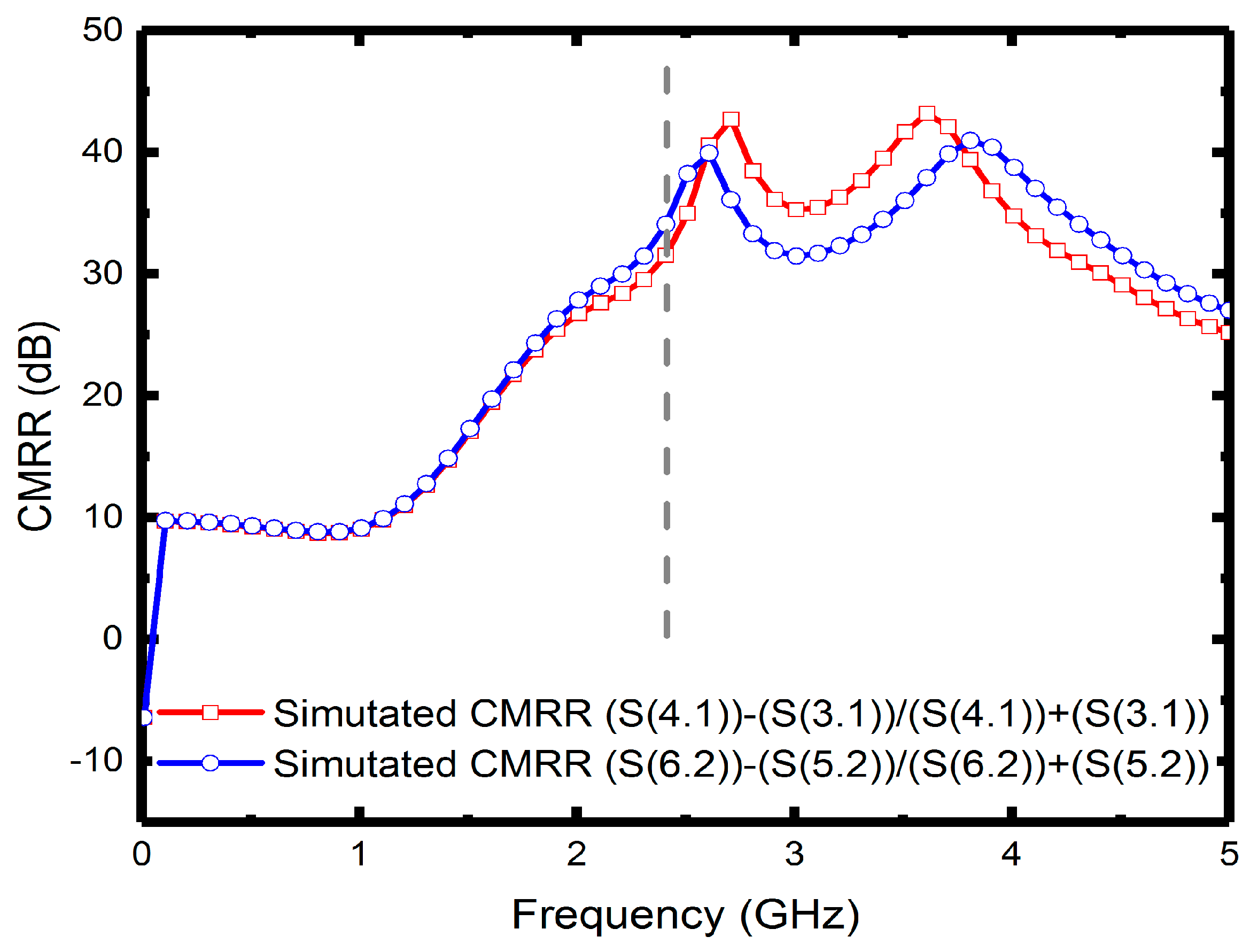
| Parameter | w | s | S1 | W1 | Wc1 | lc1 | Wc2 | lc2 | ID | OD |
|---|---|---|---|---|---|---|---|---|---|---|
| (μm) | 60 | 25 | 60 | 115 | 550 | 550 | 530 | 1225 | 345 | 760 |
| Reference | 16 | 19 | 33 | This Work |
|---|---|---|---|---|
| Technology | Microstrip Line | Microstrip Line and MEMS | Microstrip Line | MEMS |
| Single-to-diff. path | 1 | 1 | 1 | 2 |
| Operating frequency (GHz) | 2 | 2.5 | 2.1 | 2.4 |
| Return loss (dB) | N/A | N/A | −15 | −10 |
| Amplitude imbalance (dB) | 1.3 | 2.4 | 0.6 | 1.5 |
| Phase imbalance (degree) | 5.24 | 5 | N/A | 1 |
| Chip area (mm2) | 117.2 × 37.7 | 20 × 16 | 83.8 × 102.3 | 2.9 × 2.8 |
© 2017 by the authors. Licensee MDPI, Basel, Switzerland. This article is an open access article distributed under the terms and conditions of the Creative Commons Attribution (CC BY) license (http://creativecommons.org/licenses/by/4.0/).
Share and Cite
Huang, W.-H.; Huang, I.-Y.; Syu, W.-H.; Sung, C.-L.; Hsieh, C.-H. A Suspended Six-Port Transformer-Based Power Divider for 2.4 GHz Applications. Micromachines 2017, 8, 118. https://doi.org/10.3390/mi8040118
Huang W-H, Huang I-Y, Syu W-H, Sung C-L, Hsieh C-H. A Suspended Six-Port Transformer-Based Power Divider for 2.4 GHz Applications. Micromachines. 2017; 8(4):118. https://doi.org/10.3390/mi8040118
Chicago/Turabian StyleHuang, Wen-Hui, I-Yu Huang, Wun-Hong Syu, Chia-Lung Sung, and Chia-Hsu Hsieh. 2017. "A Suspended Six-Port Transformer-Based Power Divider for 2.4 GHz Applications" Micromachines 8, no. 4: 118. https://doi.org/10.3390/mi8040118





